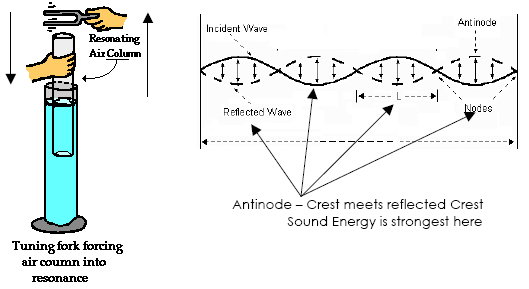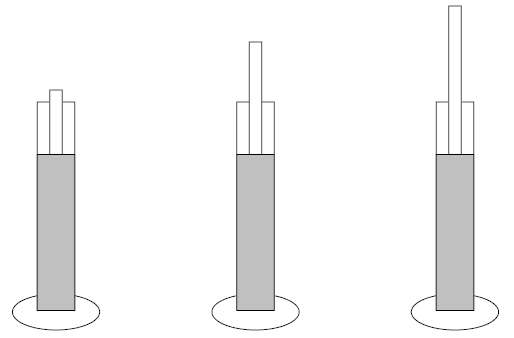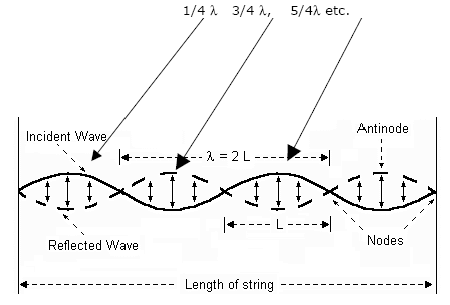Standing Waves in a Closed Tube Lab Introduction: When the sound wave from a tuning fork is sent into a closed tube, a standing wave is created. The standing wave comes about when the tuning forks wave overlaps the reflected wave from the opposite end of the tube. At certain column lengths, the reflected wave is in phase with the wave leaving the tuning fork and the two waves will reinforce each other. Certain points on the standing wave create a buildup of the sound waves energy. These points are called ANTINODES. The buildup of energy at the antinode creates a higher intensity sound at that point. The reflection of the tuning forks wave
creates a standing wave
Purpose: To find the wavelength of various frequencies of sound and the frequency of an unknown tuning fork. Materials: 1 white PVC Pipe (1 inch diameter) – 1.3 meter length, 1 clear acetate tube (1 ½ inch diameter) – 1.3 meter length, 1 ring stand, water, 2 clamps, assorted tuning forks Procedure: 1. Firmly secure the rubber stopper at the
end of the tube
Resonance occurs only at
specific PVC tube lengths: Resonance is achieved only when the tube has a length that is
Questions 1. Take the 1024 Hz tuning fork and find three column lengths that will produce resonance. *** Important – length is measured from the water to the top of the small PVC tube. Smallest length _______(2 pts) Next smallest _______(2 pts) Largest ________(2 pts) 2. In the previous step, the smallest length
that produced resonance represents ¼ of a wavelength of the sound
wave. Use this information to find the wavelength of the sound wave?
(9 pts) 3. For each tuning fork, gather data on frequency (written on tuning fork), smallest resonance length (1/4 l) and wavelength. Record this in the table given.
LEAVE THE LAST COLUMN BLANK FOR NOW (15 points)
4. a) Plot the wavelength versus frequency (6 points). b) Add an appropriate title (3 points). c) Label the axis with units (3 points)
Frequency (Hertz) 5. Using the plot above determine the frequency of your UNKNOWN tuning fork. (5 points) Record your value in the chart on the previous page 6. The shape of this plot shows that the mathematical relationship between frequency and wavelength is ___________________________ (2 points) 7. Calculate the velocity of the wave created by each tuning fork. Show all work below the data table on the previous page. (4 points each)
8. Use your data to find the wavelength of a tuning fork with a frequency of 2048 Hz.(5 points) Show how your arrived at your answer.
9. If a standing wave has a wavelength of 2 cm, at what length would you find the first resonance point? ______ (5 points) 10. What determines the speed of any wave? ____________ (5 points) 11. (a – f) The following questions refer to the standing wave shown below
|
||||||||||||||||||||||||||||||||||||||



